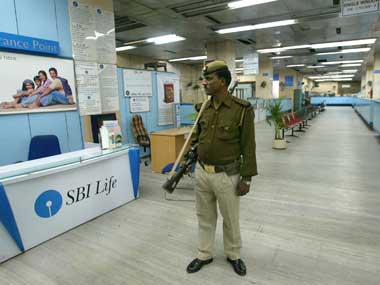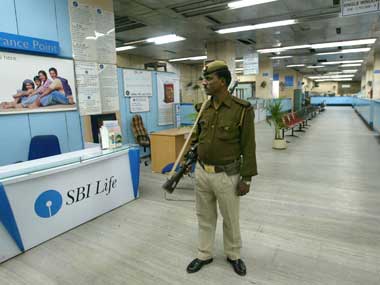Nobody, but nobody, expected the State Bank of India (SBI) to say that it had almost no profits to report in the last quarter of 2010-11. The reported net profit of Rs 20.88 crore is a fleabite when weighed against a loan-book of Rs 7,56,719 crore as on March 31, 2011. The shares duly tanked, and at the close of trading on Tuesday, the stock lost 8 percent and brought the market down with it.
[caption id=“attachment_11212” align=“alignleft” width=“380” caption=“SBI’s reported net profit of Rs 20.9 crore is a fleabite when weighed against a loan-book of Rs 7,56,719 crore as on March 31, 2011. Reuters”]
 [/caption]
[/caption]
What gives? Many reasons, really. First, the results came as a shock. If SBI was the toast of the market for much of the past five years when OP Bhatt was chairman, Tuesday’s results showed the price Bhatt paid for growth: huge bad loans. The bank’s bad loan and prudential provisioning was a humungous Rs 4,157 crore, up 76 percent from the fourth quarter figures of 2010.
Second, the new chairman Pratip Choudhuri, is in clean-up mode. By pushing all the bad numbers to the fourth quarter of 2010-11, when Bhatt was at the helm, he now starts with a cleaner slate in his term. No one will blame him for the losses of last year; his new loan-book now looks much healthier.
Impact Shorts
More ShortsThird, all this provisioning and bad news means SBI needs more capital for growth this year. But will that be forthcoming? SBI’s capital adequacy is now below 12 percent, adequate to look solvent, but not enough to support robust loan growth beyond 2011.
A question-mark has been raised about the government’s willingness to pump equity into SBI this year. The bank needs lots of capital (Rs 20,000 crore, to be exact) to keep growing and maintain its edge in the lending business, but an Economic Times report on Tuesday said the government is dithering about investing around Rs 11,000-12,000 crore to maintain its shareholding in SBI at 59.4 percent when it makes a rights issue of capital. The apparent reason: the tight fiscal situation.
That’s bull. If there is one thing the government does not lack, it’s money. At least, it has never lacked money when its political interests were at stake. Through 2007-09, the Centre has been spending money hand over fist to feed its voting constituencies by waiving farm loans, keeping petro-product prices down, and splashing money on safety net programmes like the National Rural Employment Guarantee Scheme (NREGA). Only the last is truly vital, since it helps the poorest of the poor.
So finding Rs 11,000 crore to keep its holdings in SBI constant should be a no-brainer. And it’s not even about handing over the money. All it needs to do is invest in SBI’s rights shares, and ask the bank to reinvest the cash in special government bonds. The money will be a book transfer. The bank wants to raise Rs 20,000 crore this year to strengthen its capital base and maintain the pace of lending, but if the government delays the equity infusion, SBI will lose market share.
State Bank under Bhatt has been a stellar performer because it has been behaving less like an arm of government and more like a commercial entity eager to carve out market share. To scale up in size and strength, it began the process of merging its subsidiaries with itself (two done, five more to go) and launched an aggressive loan growth strategy with its special home loan scheme. Under the latter, interest rates were kept low in the initial two years and then raised to normal rates. It was a huge hit with borrowers, especially during the 2008-09 downturn.
But this aggression caused turmoil among its private sector rivals - especially HDFC and ICICI Bank - which were forced to match SBI’s low rates with their own versions of low-priced loans (dubbed “teaser loans”). With SBI wading deeply into their turf, HDFC chairman Deepak Parekh attacked teaser loans as a “gimmick” but fought back with his own variants to retain market share.
Parekh said in an interview: “We were losing business. I still feel that teaser rates are a gimmick ; it is a marketing tool. But my marketing people said that if we do not have attractive rates in the first two years no one would come to us. So we had to fall in line immediately. So everyone is doing it now…”.
Parekh had good reason to worry. Around March 2010, the SBI overtook HDFC as India’s largest mortgage lender, thanks largely to the teaser loan scheme. But as the volume of teaser loans grew in size, the Reserve Bank of India (RBI) weighed in with new provisioning norms for teaser loans, which it felt could turn bad when interest rates rose. From 0.40 percent of loans outstanding, the RBI asked banks to set aside 2 percent on such schemes as potential loan loss provisions.
Bhatt fought back, and went down claiming the RBI simply does not understand the teaser loan scheme. He told Mint newspaper on the eve of retirement: “Of course, they have not understood it (teaser loans). These loans are, in fact, less riskier. The selection of (the) borrower is done in such a way that they are creditworthy individuals.”
Bhatt also fought tooth-and-nail with the RBI to avoid hiking the total loan loss coverage ratio to 70 percent of non-performing loans (potential bad loans, where interest is not being paid), but the RBI did not relent.
That explains the huge loss provisioning under the new chairman, but the point to underscore is this: the SBI under Bhatt was giving the private players a run for their money, and they were lobbying hard to get it to ease up on market share expansion. This is exactly what happened once Bhatt retired in April. Within days of taking over, Pratip Chaudhuri called it quits and scrapped the teaser loans.
This is where the rights issue decision of the government matters. If it does not cough up the money or finds reasons to postpone it, SBI will rapidly lose market share to private players. It would be a pointer that the government is a willing party to letting the SBI shrink in terms of market share.
If this happens, SBI would only be the latest public sector institution to be taken down the road to irrelevance under the UPA. In thepast seven years of UPA rule, ministers and babus have between them ruined the oil companies, the telecom companies and airlines in the name of public interest. Consider the evidence:
First, by refusing to raise petro-product prices when world prices went up, the three oil marketing companies have been reduced to basket cases. The Indian Oil chairman says if diesel and cooking gas prices are not raised, he will be forced to borrow Rs 7,000-8,000 crore every month to manage his operations. As oil companies bleed, and ONGC is held down by the need to subsidise the marketing companies, who’s the only beneficiary? Reliance Industries, which sells petroleum products in the world market and mints money on its gas output.
Second, telecom. In less than five to seven years, BSNL has been converted from market leader to bailout pleader. Between them, the state telecom companies BSNL and MTNL are bleeding profusely, and they will post losses of more than Rs 5,500 crore in the year to March 2011. Reason: Under Dayanidhi Maran and then A Raja, these state sector players were repeatedly restrained from competing aggressively. Now, they are waiting for their epitaphs to be written. The beneficiaries of their decline: private players like Bharti Airtel, Vodafone, Tata Teleservices, and Reliance Communications, among others.
Third, Air India. Under Praful Patel as Civil Aviation Minister, the two national carriers - Air India and Indian Airlines - were forced into wedlock without a clear game plan. Air India was also forced to buy airplanes it could not afford and forced to cede profitable routes . The airline is busy ratcheting up losses and fighting its own pilots rather than flying passengers. The beneficiaries: Jet Airways and Kingfisher, among others.
Quite clearly, when it comes to destroying taxpayer assets and public sector solvency, our political system shows unparalleled efficiency.
Under Bhatt, SBI showed the way to market expansion and growth. The downside of this may be higher short-term losses, but the critical thing now is to continue growing by boosting capital. The government needs to do its bit here. Else, one can presume it is putting a crimp on SBI’s ability to compete. Like it did with oil, telecom and airlines.
)